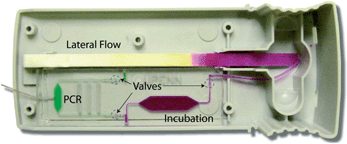A disposable microfluidic cassette for DNA amplification and detection
Abstract
A pneumatically driven, disposable, microfluidic cassette comprised of a polymerase chain reaction (PCR) thermal cycler, an incubation chamber to label PCR amplicons with up-converting phosphor (UPT) reporter particles, conduits, temperature-activated, normally closed hydrogel valves, and a lateral flow strip, was constructed and tested. The hydrogel valves, which were opened and closed with the aid of electrically controlled thermoelectric units, provided a simple means to seal the PCR reactor and suppress bubble formation. The hydrogel-based flow control was electronically addressable, leakage-free, and biocompatible. To test the device, a solution laden with genomic DNA isolated from B. cereus was introduced into the microfluidic cassette and a specific 305 bp fragment was amplified. The PCR amplicons were labelled with the phosphor (UPT) reporter particles, applied to the lateral flow strip, bound to pre-immobilized ligands, and detected with an IR laser that scanned the lateral flow strip and excited the phosphor (UPT) particles that, in turn, emitted light in the visible spectrum. The UPT particles do not bleach, they provide a permanent record, and they readily facilitate the filtering of background noise. The cassette described herein will be used for rapid testing at the point of care.


 Please wait while we load your content...
Please wait while we load your content...